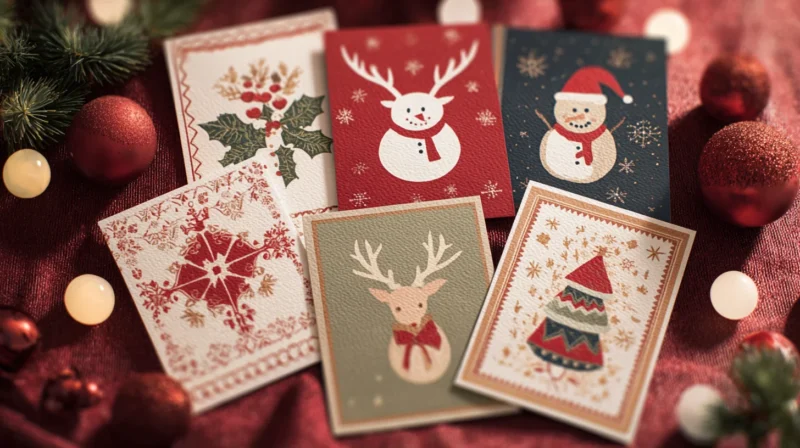In this article:
- The Hidden Power of a Holiday Card
- How Holiday Cards Strengthen Creative Networks
- Designing Cards That Feel Personal—and Professional
- Turning Seasonal Cheer into Future Opportunities
- Creative Tips to Level Up Your Holiday Card Game
- Conclusion
Designers have endless tools for promoting their craft—portfolios, social media, email campaigns. But one of the most overlooked (and surprisingly powerful) networking strategies is the humble holiday card. Yes, the same tradition your grandparents loved. When crafted with intention, a custom-designed holiday card can do far more than spread cheer—it can subtly showcase your skills, personality, and professionalism. More importantly, it helps you stay connected to people who matter to your creative career.
The holidays are a rare moment when personal and professional worlds overlap. According to a study published in Season’s Greetings: Adults’ Social Contacts at the Holiday Season, people who receive more holiday cards feel a greater sense of social connection. Over half of those cards came from people the recipients hadn’t seen in a year. In other words: sending a card can revive relationships that have gone quiet—exactly what good networking does.
Let’s unpack why holiday cards are an underrated networking tool for designers, how to make them stand out, and how to use them to gently open doors for future opportunities.
The Hidden Power of a Holiday Card
A well-crafted card isn’t just paper and ink—it’s a moment of attention. At a time when everyone’s inbox is overflowing, a tangible piece of mail stands out. It’s physical proof that someone took the time to think of you.
According to research in the Journal of Social and Personal Relationships, one of the top reasons people send holiday greetings is to maintain relationships. Even better: handwritten or personalized cards were much more likely to be perceived as genuine and relationship-strengthening than generic ones.
This isn’t a coincidence. The act of creating and sending a holiday card mirrors what strong networking is built on—personal effort, empathy, and attention to detail. And designers have an edge here because their medium is design.
A custom holiday card is a tactile portfolio piece that lands directly in someone’s hands. It says, without saying: This is what I can do.

Get 300+ Fonts for FREE
Enter your email to download our 100% free "Font Lover's Bundle". For commercial & personal use. No royalties. No fees. No attribution. 100% free to use anywhere.
How Holiday Cards Strengthen Creative Networks
Let’s be honest—networking can feel awkward. Cold emails? Forced coffee chats? No thanks. But a holiday card reframes the interaction. It’s friendly. Seasonal. Non-intrusive. It’s a reason to reach out without asking for anything.
In fact, holiday cards work particularly well for maintaining what sociologists call weak ties—those acquaintances, former clients, or art directors you haven’t talked to in months. These are often the people who bring unexpected opportunities.
A study in Season’s Greetings found that more than half of the holiday cards received were from people recipients hadn’t seen in a year or more. Those are dormant connections being rekindled through a single thoughtful gesture. That’s networking, done creatively.
And here’s the best part: the card itself becomes a conversation starter. Maybe a former client replies to compliment your typography. Maybe a creative director keeps your card pinned above their desk. Small touchpoints add up—and that’s how you strengthen business connections without ever sounding salesy.
Designing Cards That Feel Personal—and Professional
A card doesn’t need to be flashy to make an impression. It needs to feel intentional. That means considering the design, tone, materials, and message together as one cohesive experience.
1. Design with Personality
Your holiday card should reflect your design sensibility. Think of it as a mini self-promo piece that still fits the season’s warmth. A few ideas:
- Use typography as a design centerpiece.
- Incorporate your illustration style subtly.
- Play with layout or white space in unexpected ways.
- Use your brand colors in festive variations.
Keep it authentic—if your design identity is bold minimalism, don’t suddenly go glitter-heavy. Let your card whisper your brand, not shout it.
2. Choose Memorable Materials
Texture and finish make a difference. Specialty papers or letterpress printing can turn a simple concept into something people want to keep. According to a Keypoint Intelligence study, 97% of marketers found that personalized or specialty print pieces had higher response rates.
That means tactile quality matters. Use it to your advantage.
If you’re unsure how your design will print, business card size guides are great references for understanding proportion, bleed, and layout across print products.
3. Keep the Message Simple
You don’t need to write a novel. A sincere note is enough:
“Wishing you a season filled with creativity and new inspiration. It’s been a joy staying connected this year!”
You can also add a subtle personal touch—mention a project you admired or a conversation you enjoyed earlier in the year. Authenticity beats formality every time.
Turning Seasonal Cheer into Future Opportunities
So you’ve sent your cards. Now what?
1. Follow Up Thoughtfully
You don’t need to follow up immediately—but the card gives you a reason to check in later. For example:
- In January, send a quick message: “Hope you enjoyed the holidays! Did my card make it your way?”
- Or if you included a small print or mini-poster version, ask how they displayed it.
Small follow-ups show care without pressure. They bridge that gap between personal gesture and professional communication.
2. Track Who You Send To
Keep a simple spreadsheet or note in your CRM of who received cards. That way, next year’s list builds on your network—and you can tailor future cards based on responses.
3. Use Data to Guide Your Effort
The science supports this strategy. According to PostcardMania’s 2025 meta-analysis, direct mail response rates are 5 to 9 times higher than other marketing channels. Nearly 40% of consumers tried a business for the first time after receiving direct mail. So while your card might seem like a small gesture, it sits within a proven communication channel that gets noticed.
4. Think Like a Network Scientist
Even academic research on business card exchange networks shows that physical exchanges play a measurable role in professional link formation. They found strong homophily—people form connections based on shared interests and traits. Your card, therefore, becomes a small artifact of connection, bridging that shared ground.
When you combine creative design with sincere outreach, you’re not just sending mail—you’re strengthening the structure of your professional network.
Creative Tips to Level Up Your Holiday Card Game
If you’re ready to make your holiday cards a true extension of your design brand, consider these creative touches:
- Add interactivity. QR codes linking to your portfolio or a “behind-the-design” video can be a fun surprise.
- Include a small print or sticker. Something recipients might keep or display.
- Experiment with shape. Not all cards need to be rectangles. Die-cut forms can add playfulness.
- Think sustainably. Recycled materials or minimal ink usage show thoughtfulness.
- Include a subtle signature element. Maybe a recurring motif across years—a thread that people start to recognize.
These small decisions elevate your work from seasonal nicety to memorable creative communication.
Conclusion
Networking isn’t about collecting business cards—it’s about building meaningful, lasting connections. And sometimes, that starts with a beautifully designed holiday card.
Sending a thoughtful, well-crafted piece of mail each year not only shares your creative spirit but also quietly markets your design sensibility. It reconnects you with dormant contacts, opens new conversations, and reminds people of your craft in a tangible, heartfelt way.
In an era where digital messages vanish in seconds, a physical card still holds weight. It’s a reminder that creativity isn’t just seen—it’s felt. And that’s exactly what makes a holiday card a designer’s secret networking tool.





